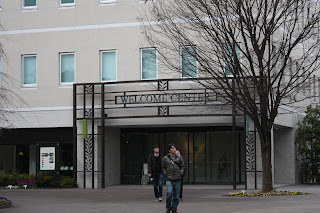Yes, this weekend deserves 3 posts!
Saturday was 建国記念の日 / Kenkoku Kinen no Hi (National Foundation Day), a national holiday celebrating the ascension of the first Japanese Emperor over 2600 years ago.
My friend had learned that there would be a special ceremony at Atsuta Shrine, so we went to watch.
Atsuta Shrine is one of the top ranking Shinto shrines in Japan. It houses a sacred sword, Kusanagi, said to be a gift from the goddess Amaterasu, and represents the authority of Japan's emperors.
The ceremony on Saturday was to pray for the health of the Emperor, and for the country as a whole. Like most Shinto rituals, most of the ceremony was not visible to the public.
Here is the shrine itself.
We could see the priests' procession.
They then proceeded to the inner shrine, which is off limits to the public. The public could watch the ceremony, and pray in the outer shrine.
We went for a walk around the grounds. The entire grounds contains several smaller shrines and some other sacred things, such as an old, large tree. Shinto as a religion reveres kami (gods) that often appear as natural objects such as trees, mountains, etc. Mt. Fuji, for instance, is a sacred mountain and has a shrine at the top.
After that, we watched an archery ceremony, which is carried out for the pleasure of the kami.
As a martial art, Japanese archery is called 弓道 / kyuudo. If you've read "Zen and the Art of Archery" by Eugen Herrigel, this is the archery mentioned in the book. If you have not read it, I recommend it. It's a short read, and a good introduction to Zen Buddhism.
Both men and women participated, wearing beautiful costumes.
Here are the women archers.
Here is the target.
The weather was rather chilly, so I imagine the participants were even colder than we were!
After this, we went to find a nice hot lunch. There are several restaurants around Atsuta Shrine that serve hitsumabushi, which is basically unadon, or eel on rice. The name of the dish comes from the dish it's served in, which is the container that rice is usually brought to the table in. I usually eat small portions, so I ordered what was called a mini-hitsumabushi with sashimi (raw fish) and chawanmushi (egg custard). I also ordered a "Made in Nagoya" beer, not expecting the very large Kirin bottle!
The eel is the center back, chawanmushi in the back left. Hitumabushi is eaten in four portions in the empty bowl in front. The first part is eaten plain. The second portion is eaten with the scallion and nori (seaweed) condiments. The third portion is eaten with the broth in the small teapot poured on top. Finally, the fourth portion is eaten whichever way you like best.
I love sashimi -- this was wonderful maguro.
Here is chawanmushi. It often has chicken or shrimp inside.
Here's the "Made in Nagoya" beer, which went well with the eel.
The founder was motivated by the unequal trade agreements that Japan was forced to sign after the arrival of Commodore Perry's black ships. He knew that Japan needed to have exportable products to balance trade with the West.
These are the original factory buildings.
Here are the current buildings. Noritake has facilities in other places in Japan as well as other countries around the world.
We were able to paint plates ourselves! They will be fired, then shipped to us in Japan.
Here's mine.
My friend's plate is on the top. I think she has the steadier hand, but I enjoyed painting mine as well.
All in all, this is the best weekend I've had in a long time. I still can't believe I've finally met my friend of eight years! Sometimes life is very good to me, and this was one of those times.


























No comments:
Post a Comment